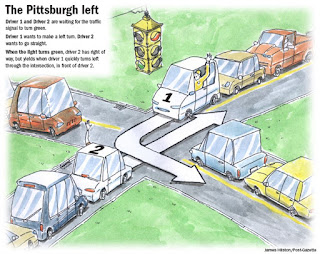 |
| The infamous Pittsburgh Left. The first vehicle at a red light will (sometimes) turn left when the light turns to green. |
Some factors to consider when deciding what events and behaviors your system needs to predict include:
- Determining expected behaviors of other objects, which might involve a probability distribution and is likely to be based on object classification.
- Normal or reasonably expected movements by objects in the environment.
- Unexpected, incorrect, or exceptional movement of other vehicles, obstacles, people, or other objects in the environment.
- Failure to move by other objects which are reasonably expected to move.
- Operator interactions prior to, during, and post autonomy engagement including: supervising driver alertness monitoring, informing occupants, interaction with local or remote operator locations, mode selection and enablement, operator takeover, operator cancellation or redirect, operator status feedback, operator intervention latency, single operator supervision of multiple systems (multi-tasking), operator handoff, loss of operator ability to interact with vehicle.
- Human interactions including: human commands (civilians performing traffic direction, police pull-over, passenger distress), normal human interactions (pedestrian crossing, passenger entry/egress), common human rule-breaking (crossing mid-block when far from an intersection, speeding, rubbernecking, use of parking chairs, distracted walking), abnormal human interactions (defiant jaywalking, attacks on vehicle, attempted carjacking), and humans who are not able to follow rules (children, impaired adults).
- Non-human interactions including: animal interaction (flocks/herds, pets, dangerous wildlife, protected wildlife) and delivery robots.
(This is an excerpt of Koopman, P. & Fratrik, F., "How many operational design domains, objects, and events?" SafeAI 2019, AAAI, Jan 27, 2019.)
No comments:
Post a Comment
All comments are moderated by a human. While it is always nice to see "I like this" comments, only comments that contribute substantively to the discussion will be approved for posting.